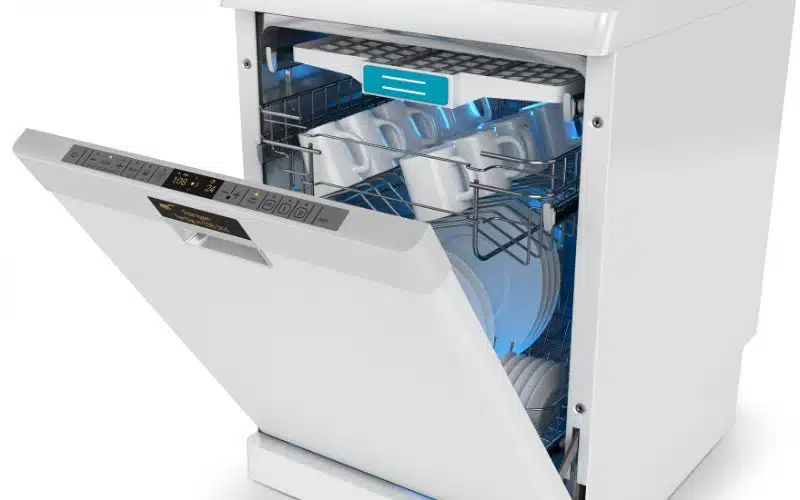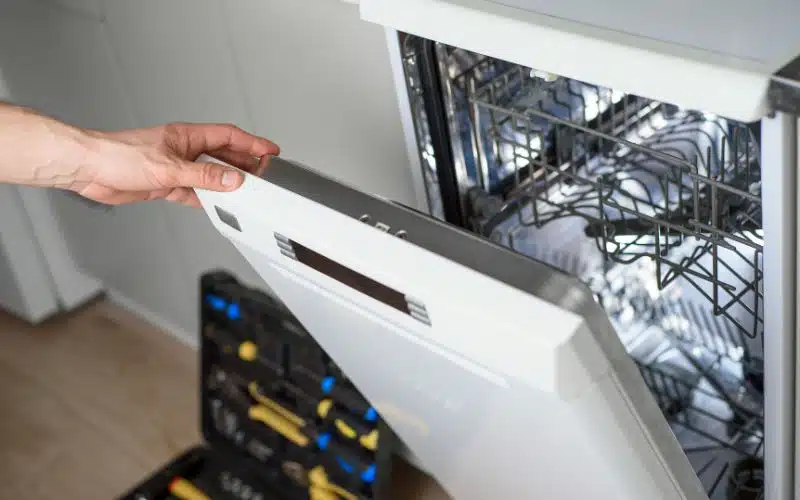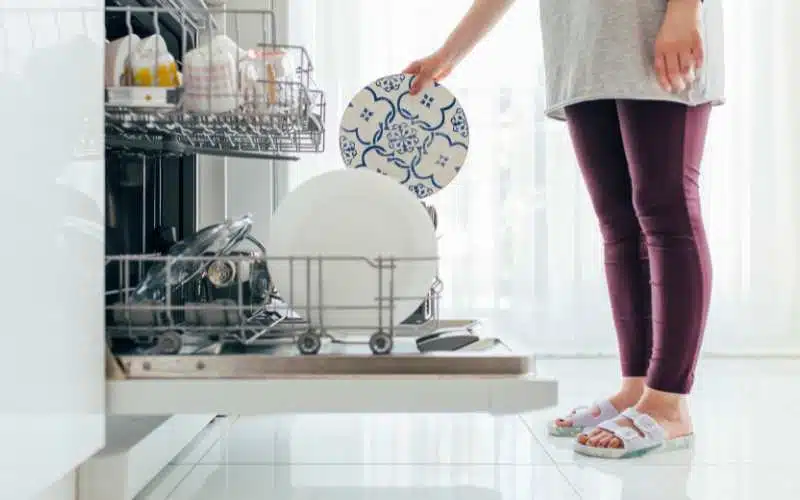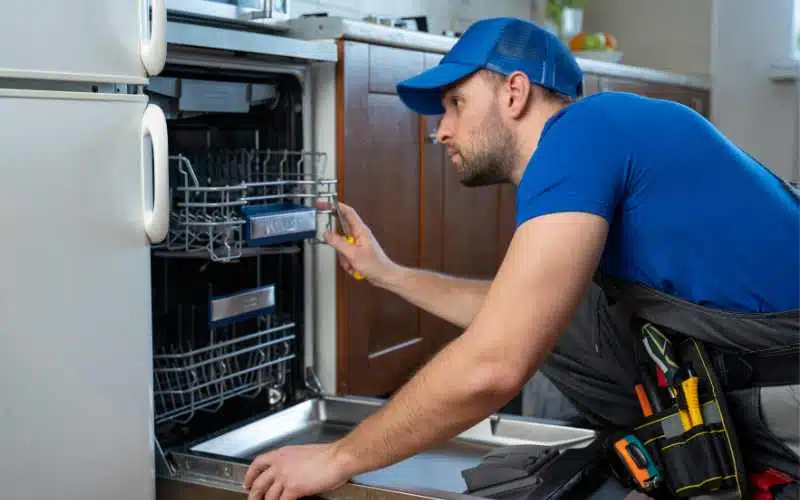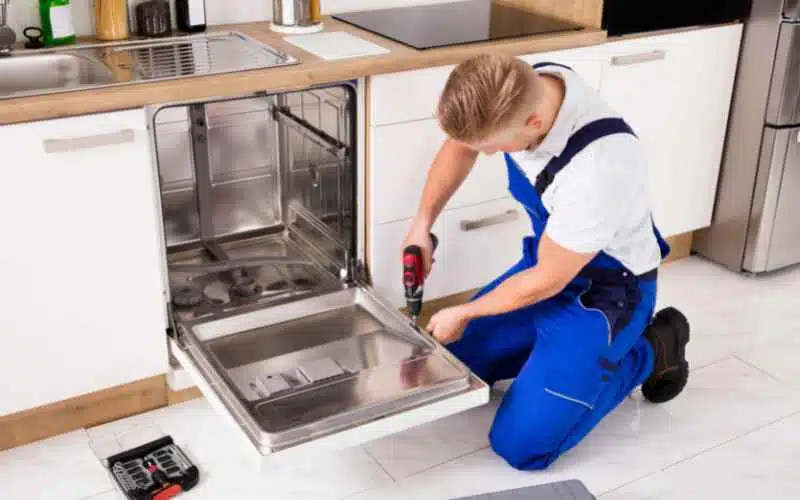The dishwasher soap dispenser is responsible for supplying soap to the dishwasher.
Generally, the cleaning process for the dishwasher requires you to press the ON button and have your dishes done.
However, a dishwasher is a machine capable of developing faults at some point, such as retaining soap residues that remain in it after a wash cycle. So, why does this happen?
Most times, dishwasher soap dispenser faults arise due to the buildup of food particles and dirt on the soap cup, which can eventually damage the dishwasher. Secondly, all dishwashers have a recommended temperature at which they run; when the temperature is too low, soap residues will likely remain after each wash cycle.
Dishwasher Soap Dispenser Opens, But Soap Remains Inside It
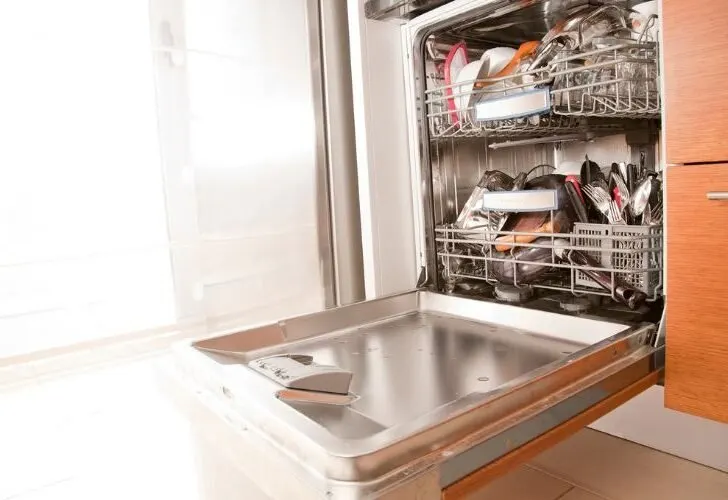
Most homeowners assume that a clogged dishwasher is the most unpleasant issue that can arise from using a dishwasher.
However, having soap remains inside your dishwasher soap dispenser is just as frustrating as having a clogged or stuck dishwasher.
In this article, I will outline the common reasons why the dishwasher soap dispenser has soap remains in it.
#1. Accumulated Soap
The most common cause of soap dispenser issues Is the accumulation and buildup of soap or detergent on the soap cap.
Dishwashers self-circulate water and soap for washing dishes. However, when the soap dispenser becomes clogged with soap buildup, it leads to your dishwasher having soap remains in it.
This accumulated dry soap prevents the free supply of soap and causes friction on the latch of the soap dispenser when opening and closing it.
You can use a neat and damp microfiber cloth to clean the dry soap.
#2. Low Temperature
Low temperature is also another common cause of dishwasher soap dispenser failure.
Most times, low temperature slows down the rate at which water flows from the dishwasher to the soap cup.
Usually, you can clear the error by increasing the dishwasher’s temperature. You can also consult the machine’s manual for the appropriate temperature your dishwasher runs on.
Whirlpool Dishwasher Soap Dispenser Opens, But Soap Remains Inside It
After running a cycle, you should consider a few things when you notice detergent at the bottom of your Whirlpool dishwasher soap dispenser.
The most common cause is the type of detergent and the position of the upper racket.
| Type of Soap | Explanation |
|---|---|
| Type Of Soap Used In Washing | When soap builds up or becomes caked, cleaning out the soap cup always helps. When exposed to air, old and undissolved soap forms clogs and clumps on the soap dispenser. The clumps cause the dispenser door to become stuck in wash mode most of the time. Since detergent packets dissolve better, you can use them more than soaps or powders. If your detergent soap remains after each wash, increase the water temperature, make the water hotter, and run it in a cycle without loading dishes in the dishwasher. |
| The Position Of The Upper Rack | Dishes, as you know, are placed in racks inside the dishwasher. The upper rack can be removed and adjusted to fit the sizes of the dishes you are running at a time. Hence when you readjust the rack to a lower position, it becomes challenging to dispense detergent because the back blocks the soap dispensers when they are in a low position and even loose. A loose rack also causes the dishes to swerve around inside the dishwasher. |
KitchenAid Bosch Dishwasher Soap Dispenser Opens, But Soap Remains Inside It
The common reasons why KitchenAid dishwasher malfunctions in dispensing soaps at the end of a cycle are faults from other parts of the dishwasher or the soap dispenser itself.
Usually, replacing is the best option, especially after thoroughly inspecting the faulty parts.
They include the bi-metal, detergent container, soap dispenser cover, dispenser actuator, dispenser door pin and spring, dispenser latch, lever, lid, repair kit, slide, and the main control board.
Ge Dishwasher Soap Dispenser Opens But Soap Remains Inside It
For a Ge dishwasher, when soap and detergents constantly remain in the dispenser after running a cycle, it is usually an indication that water is not supplied to the soap cup sufficiently or that the dishwasher is running at a low temperature.
You can also check the spray arm for blocked spray holes or soap cups due to food particles, pieces of plastic, and even silver wares.
A damaged dishwasher door can also cause soap to remain in the dishwasher at the end of a cycle.
Generally, the appropriate water temperature for a dish cycle is 120 degrees Fahrenheit.
A slight increase or decrease in the water temperature increases the likelihood of detergent getting stuck in the soap cup.
Dishwasher Soap Dispenser Opens But Soap Remains Inside It – Troubleshoot And Diagnosis
A faulty dishwasher soap dispenser can get frustrating when you want to use it.
However, there are quite a few fixes for most dishwasher issues. Furthermore, a single fault does not suggest that your dishwasher is beyond repair.
For example, a malfunction in the soap dispenser could be because of a complex reason like a damaged soap cup or as basic as a soap cup being improperly closed during a cycle.
Here are a few diagnoses for dishwasher soap dispenser issues and how to troubleshoot.
#1. Soap Density Issue
The primary function of all dishwashers is to wash dishes with a squeaky look and outstanding slickness.
Hence all dishwashers have soap dispensers. The soap dispenser is the function of both old and new models of dishwashers.
Although all the new models have more miniature water-based soaps that often result in soap build, they clean more efficiently than most older models.
Therefore the model of dishwashers you own often contributes to the efficiency and quality of work it does.
#2. Dirty And Broken Door Latch
While a sturdy latch helps keep dishes in place, a damaged latch will loosen up and cause dishes to swerve inside the dishwasher when running a cycle.
Secondly, door latches are the most touched part of the dishwasher. They also are frequently exposed to water and food particles.
A dishwasher door latch can become problematic for so many varying reasons. The common reasons are
- A worn-out or defective door latch.
- Metal fatigue.
- Door breakage from accumulated soap.
- Weak door springs.
#3. A Clogged Soap Cup
Usually, when the soap in the dishwasher soap dispenser refuses to dissolve, the culprit is a clogged soap cup or insufficient water supply to the soap dispenser.
As soon as you notice this, ensure you run a wash cycle with warm water and detergent without loading dishes in the dishwasher.
However, if running an empty wash cycle does not help, try removing everything around the soap cup that may hinder water flow.
#4. Check And Raise the Temperature
Low-temperature settings are a possible reason your dishwasher soap dispenser malfunctions by leaving residues of soap at the bottom of the dishwasher after each wash cycle.
In addition, dishwashers mostly require boiling water to cut through grease and debris than the typical kitchen sinks.
Dishwashers require high temperatures to wash correctly at all times. Aside from cleaning, better high temperatures help in minimizing the amount of soap used for each wash cycle.
#5. Defective Springs
The soap dispenser springs on the dishwashers may get defective or damaged quicker than any other part of the dishwasher.
The reason is that the springs on the dispenser may become slacked and therefore lose their sturdiness as you open and close the soap cup continuously since it is a product of very light metals.
Once the springs get broken, it becomes tough to run a wash cycle without having detergent or soap remain at the bottom of the dishwasher each time.
In addition, since day springs on the soap dispensers are often difficult to replace or repair, running a wash cycle will often require you to open the soap cup manually for each cycle.
#6. Warped Soap Dispenser Door
Most older models of dishwashers have very high temperatures when it comes to running a cycle.
However, a warping soap dispenser door is likely a common problem in newer models of dishwashers too.
Whenever the temperature of a cycle is hot or the dry heat cycle is too hot, there is always the likelihood of the delicate parts of a dishwasher getting damaged.
Unfortunately, one of these parts is the dishwasher soap dispenser. Fortunately, you can resolve the issue by using simple tools in the home, such as a screwdriver, or you can decide to seek the help of a professional.
#7. Damaged Wax Motor
A wax motor is designed to time a wash cycle and trigger the soap dispenser at intervals during a wash cycle.
A faulty wax motor is why the soap dispenser will not respond or open up when you want to run a wash cycle.
A minor or significant problem on the wax motor will cause it to either stop working or respond at the appropriate time needed.
Whatever the case, always ensure to replace the wax motor as soon as you notice it has become defective.
#8. Slagged Rinse Aid Cap
The cap on the rinse aid is essential for it to work correctly. As expected, it should always sit firmly in its place during a cycle.
Some dishwashers have their rinse aid as an internal compartment and may require you to check if it is loose or has fallen off. The issue could be a loose screw, a defective solenoid, or a missing gasket.
#9. Broken Soap Dispenser Door
A broken soap dispenser door is one of the issues that arise from purchasing a cheap model of dishwashers; hence it is not a common reason for high-quality dishwashers.
Furthermore, the doors on cheap dishwashers are products of soft materials, parts, and poor construction.
Therefore, once the soap dispenser door is broken or damaged, it is recommended that you fix the parts or, better still, avoid buying cheap and poorly constructed products.
#10. Faulty Gaskets
The gasket is usually a dark or black-colored ring around the dishwasher’s door.
Hence, their installment is to keep the detergents in place and ensure that it does not leak to the other parts of the dishwasher.
Therefore, it does not just keep or seal soaps in the soap cup but also ensures that liquid and soap do not flow out inappropriately or when it is not running a cycle.
However, it is prone to wear and tear, but you can fix it by moisturizing the gasket with cooking oil or vegetable oil. Therefore, replacing the gasket is usually unnecessary since you can fix it quickly.
Final Thoughts
Dishwasher soap dispenser faults arise from soap buildup, clumps, food particles, and dirt on the soap cup.
Low water temperature and faulty dishwasher parts also cause a malfunction in the soap dispenser when running a cycle and at the end of a cycle.
However, replacing the faulty parts helps deal with dishwasher dispenser issues.
